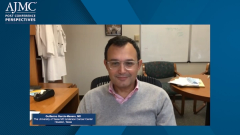
Treatment Patterns in the Management of MDS
In his closing thoughts, Dr Garcia-Manero provides an overview of the treatment management approach for patients with MDS.
Guillermo Garcia-Manero, MD: I think the bottom line is these data suggest that maybe we are not treating as many patients as we should, and that probably outcomes are significantly inferior compared to what we see in clinical trials. And that we need to do better in terms of getting these drugs to the finish line and starting to see improvements in responses and survival that will encourage community physicians to offer these therapies. Understand that myelodysplastic syndrome [MDS] is a disease of older individuals who may have other comorbidities. And sometimes it’s challenging to offer treatments that may not give patients a significant improvement in their outcome. That’s why, going back to these questions about hypomethylating agents, that’s so nice. Because that in a way probably should facilitate a bit how we treat these patients. I think these kinds of data suggest that we are not doing as well—not the community doctors, but us—translating this kind of knowledge into the care of our patients. That we need to do better at all levels. It’s very disappointing to see that only a fraction of our patients are treated with hypomethylating agents for instance, and that the outcomes we see when those patients are treated in that particular context are far inferior to what you see from those clinical trials.
We designed these clinical trials in terms of response rate or survival, and it’s all based on expectations that seem to be always moving. We don’t really know what the actual target is. I think these kinds of data give you the benchmark. I don’t know how you design a trial to beat that. Of course, you could say why don’t we do those trials more in the community than in tertiary care centers? But I don’t know how you would go about this. So it’s interesting. And I think that if this analysis was done outside the United States, it would be even worse. Not that we do better care than other countries, but in some countries where maybe economic possibilities are lower and things like that, I think we would be shocked by what happens. So this has implications not only in the United States but globally.
The question is how do you design a real-world clinical trial that then allows you to approve the next drug? Because maybe the way we design these trials is artificial, based on whatever threshold we design based on our prior experience in various select and nondiverse centers. At the end of the day, to make it easy, there’s always a regression to the norm, I think that’s how we refer to this. If you have drugs that are really good or combinations that are really powerful, even if they regress a bit, they will do better than presently. And I think there would be a greater uptake of this kind of intervention. Because at the end of the day, the doctors and the patients will decide what to do, if it’s worth their effort, etc. So we need safe, effective combinations that prolong survival.
There were so many presentations focusing on MDS, so it’s obvious that there’s a group of people who want to improve those outcomes. No doubt about it. I don’t think there were any spectacular data where we said this is going to be the new approval, but it’s obvious that there’s a very significant effort, and we are going to get there. There were a lot of presentations on prognostic models and validation. So that’s interesting. We saw some interesting data detailing things like DDX41 or TP53 mutations at a very high level. That is allowing us to understand better these diseases. There were a couple of presentations, for instance with the STIMULUS trial, giving us a hint of what may happen in the future with this type of TIM3-based immunotherapy in these diseases. We saw data in CCUS [clonal cytopenia of undetermined significance] and CHIP [clonal hematopoiesis of indeterminate potential]. I thought our group presented very interesting data with canakinumab in low-risk MDS. We started to see the use of single-cell analysis as a correlative biomarker. So I think we are doing a lot of work. Now of course, next year we hope will start listening to results from the phase 3 trials VERONA, ENHANCED, and COMMANDS. Also the IMerge trial.
We have around 4 major clinical trials that I don’t know if they’re going to read out exactly in 2023 or early 2024, but soon we should be listening to some of these. Let’s hope that at least 1, if not all, are positive, and we could be having a very fun interview next year with a lot of positive data.
Transcript edited for clarity.
Newsletter
Stay ahead of policy, cost, and value—subscribe to AJMC for expert insights at the intersection of clinical care and health economics.








































